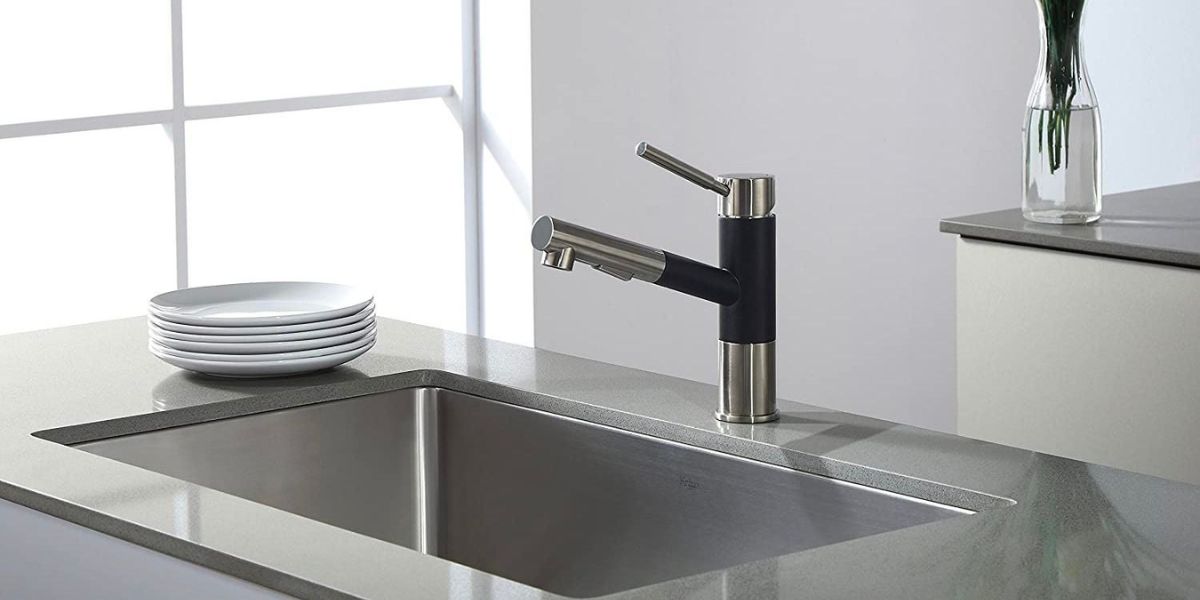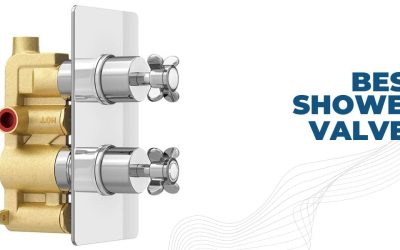Renovations to the kitchen center around the kitchen sink. Most trusted plumbers, contractors, and homeowners rely on the underside mounting kitchen sink due to its usability and seamless look to the kitchen counter and its interior.
Since undermount sinks are mostly heavy, they are made with sturdy materials like solid granite, marble, concrete, and stainless steel.
It is more typical to see rectangular undermount kitchen sinks for laminate countertops or butcher block countertops, but there are more shapes and styles available in the market.
However, the stainless steel undermount kitchen sink is unbeatable if you combine affordability with toughness.
So, we made it simpler for you to find the best stainless kitchen sink by gathering the top 12 best rated undermount kitchen sinks.
Without much further ado, let’s get started!
Is stainless steel good for a kitchen sink?
Undoubtedly, stainless steel is an incredible material for kitchen sinks due to its sturdiness, low maintenance, and resistance to heat, rust, and corrosion. It is a mix of iron, carbon, and other alloys like silicon, carbon, manganese, nickel, and nitrogen. As a result, it has a sturdy structure, and the minimum 10.5% chromium content makes the surface corrosion-resistant.
The grade chart shows the strength of the stainless steel material, so you can choose the type that will be most useful to you and last the longest. However, the exact mixtures distinguished the grades of stainless steel.
The two stainless steel grades that are most frequently ordered globally are 304 (first) and 316 (second) on the stainless steel grade charts. 304 stainless steel is used for storage tanks, automotive trim, kitchen equipment and appliances, and indoor electrical enclosures, whereas 316 is for chemical, medical, and pharmaceutical equipment, commercial kitchen appliances, and so on.
Above, we learned about the core of stainless steel, but now we come to the question, “Why is stainless steel material good for kitchen sinks?
- Hygienic & Maintenance- Its easy cleaning ability and low maintenance make it useable for dilly-daily tasks.
- Rust-and-corrosion Resistance- Its chromium alloy prevents corrosion and makes it useful in all circumstances.
- Fire-and-heat Resistance- Its high chromium and nickel-alloyed grade resists scaling and maintains high strengths at high temperatures.
- 100% Recyclability- Almost half of the old stainless steel scrap remelts completely to manufacture the new ones.
- Pleasing Look- The stainless steel’s metal surface attracts most homeowners because of its sleek and classic touches.
- Easily Fabricated- Welding, bending, forming, assembling, and fabricating easily with the stainless steel compared to the traditional.
Advantages and disadvantages of a stainless steel undermount kitchen sink
A stainless steel undermount sink is unquestionably the best upgrade from a classic to a modern kitchen countertop. The sink has so many advantages, but it cannot be denied, however, that it has drawbacks too.
Let’s make things clearer before buying!
Pros
- Durability: Stainless steel undermount sinks last a very long time, without a doubt due to the mixture of versatile alloys that forms it tougher.
- Affordability: No matter how thick the steel gauge is or how the sink bowl is designed, stainless steel costs are significantly less.
- Easy to clean: The undermount sink’s core USP is that it is easier to clean. If one is made with this material, maintenance requirements are reduced as well. Sweep the countertop with soapy water and crumbs straight with a sponge easily.
- Several options are available in shape and style: Its recent technology lets folding into various shapes and styles without sacrificing strength. So you can furnish your worktop with your chosen shapes and justify the kitchen interior decor.
Cons
- Prone to scratches and dents: Although stainless steel is a durable material used in a wide variety of household appliances, frequent use makes it susceptible to dents and scratches.
- Limited color options available: Stainless steel comes in a pure silver color, but if you’d like, you can color it using paints or chemical processes. But it cannot be accurately repaired if it is damaged after color.
The Top 12 Best Undermount Stainless Steel Kitchen Sink 2023
Product no. | Preview | Product | Rating | Review |
1 |  | Elkay stainless steel undermount sink | ||
2 |  | Kohler stainless steel undermount sink | ||
3 |  | Kraus undermount kitchen sink | ||
4 |  | Zuhne stainless steel undermount kitchen sink | ||
5 |  | Ruvati undermount kitchen sink |
The 12 Best undermount stainless steel kitchen sinks: Reviews & guide
Are you looking for the perfect kitchen sink to complete your dream kitchen? If you are, then you’ve come to the right place! We’ll be discussing the top 12 best undermount stainless steel kitchen sinks of 2023.
We’ve done the research for you and compiled a comprehensive list of the best undermount stainless steel kitchen sinks.
So, whether you’re renovating your kitchen or just looking to upgrade your sink, read on to find the perfect one for your home. We’ll be comparing and reviewing the top 12 options to ensure you don’t end up with phony sinks that are all show and no go. Let’s get started!
1. Elkay 16 Gauge single bowl stainless steel undermount sink
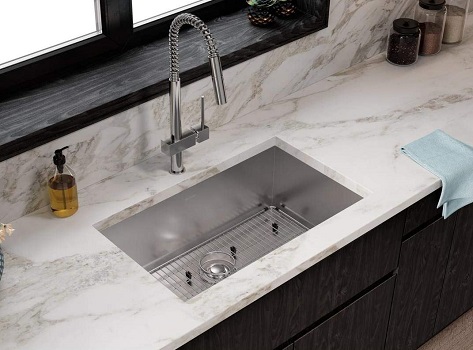
Latest Price On
Elkay’s top-rated stainless steel undermount sink combines beauty with sturdiness. It is the Elkay Crosstown 16 gauge stainless steel kitchen sink. Its striking geometrical shapes embellish the area around your countertop.
Size: Elkay’s Crosstown stainless steel undermount sink is a single bowl that is 31 inches wide, 18 inches long, and 10 inches deep. It also has a zero radius corner so that you have more usable space inside for washing dishes and sweeping up food debris easily.
You can easily drain the soapy water or the water used to rinse fruits, vegetables, and other foods thanks to the sink’s bottom’s cross-break lines and its superior drainage system.
Material: As you know, the lower the gauge number, the thicker the stainless steel. To create kitchen appliances, 18-gauge stainless steel is the material most frequently used. While this 304-grade stainless steel is 16-gauge instead of 18-gauge, is more resilient to heat and stains. This strongest material made your kitchen sink will last for more than ten years.
Silent operation: The product is made of the thickest, 16-gauge stainless steel materials, which minimizes noise and vibration. It eliminates over 80% of the sound coming from the sink and makes it possible to complete dishwashing tasks in silence.
Accessories: Last but not least, like the majority of top-quality Elkay kitchen sinks, the Elkay Crosstown EFU281610T undermount sink includes a custom-fit bottom grid, deep strainer drain, cleanser, and microfiber towel. All of these accessories are packaged in a protective cloth bag from Elkay.
There is no doubt that Elkay can save money to spend on other kitchen accessories.
Pros
- Value for money
- Immense durability
- High-capacity bowl
- Noise reduction technology
- Sleek look and a flat bottom with more usable space
Cons
- Sensitive to scratches
2. Kohler 18 gauge stainless steel undermount sink
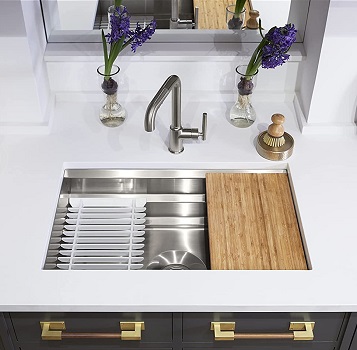
Latest Price On
The 29-inch workstation undermount rectangular kitchen sink from the Kohler Prolific series is a highly functional workstation. When performing heavy tasks, the basin’s novel three-ledge grid increases efficiency. Undoubtedly it is one of the best space-saving undermount sinks.
Functionality: As a workstation, this undermount kitchen sink enables multitasking through the use of its accessories. For instance, the bowl’s three graduated ledges let you position the accessories at the ideal height. Garbage disposal is simple thanks to the beveled cone-shaped basin’s slope into drains. Other items like a bamboo cutting board, grated racks, a colander, and so forth make the hometasker versatile.
SilentShield Technology: Kohler’s silent shield technology has thick soundproof padding all the way around the thigh radius corners. As a result, there is less chance of scrubbing stains, and it is quieter when doing heavy dishwashing, rinsing vegetables, and other messy and noisy tasks in silence.
Easy Maintenance: The corners of this kitchen sink are extremely sharp, preventing the possibility of any dirt accumulation and making cleaning them even easier. Simply give the entire basin a thorough rinse, and the cone-shaped basin’s sloped bottom made it simple to drain all the water and crumbs.
Installation: Because it has so many features, the installation procedures are a little bit cumbersome. Therefore, it is best to seek the advice of experienced plumbers because occasionally, an under-counter installation may not fit properly in the cutout and result in leaks.
Pros
- Versatile in functions
The use of excellent sound-absorbing technology - Simply cleaning with the cone-shaped basin slope
Cons
- Somewhat expensive
3. Kraus undermount single bowl stainless steel kitchen sink
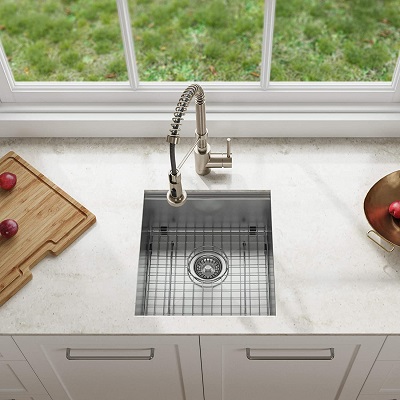
Latest Price On
First up on the list for the best undermount stainless sink today, we have the KWU111-17 undermount workstation from Kraus. From professionals to beginners, this undermount sink is a dream come true in the form of a workstation.
Size: This stainless sink comes in several different sizes, from 17 inches to 57 inches, depending on how much space you have or need. It fits inside a minimum cabinet size of 21 inches. And the width is usually two-inch more than the length to make it more spacious during use.
Space: As it’s an undermount sink, it’s seamlessly mounted inside the countertop. The workstation comes with integrated ledges that allow you to slide necessary accessories against the sink. Thus, you can easily cut, clean, and prep your food without losing much space on the kitchen counter.
Efficiency: The Kraus KWU111-17 is a single bowl undermount sink. It has tight radius corners and an offset drain that gives you maximum efficiency while working.
Furthermore, the proprietary noise-defend and soundproofing with extra protective undercoating minimize all sorts of vibrations.
Material: Next up, let’s find out about the material quality of this undermount workstation-style sink. This sink from Kraus is made from Tru16, which is the thickest steel on the market as of now. It’s heavy-duty 16-Gauge stainless steel, which is not only super sturdy but also rust and water-resistant.
Accessories: Finally, this sink comes with a few added perks. The package includes a chef’s kit that has a great bamboo cutting board, bacterial dish grid strainer, and drain cover. The bamboo cutting board prevents odor and is protected from cracking or warping.
So, if an undermount workstation-style sink is what you need, you can just go and buy this one instantly.
Pros
- Great drainage system
- Comes with a CChef’sKit
- Single bowl and spacious
- Perfect workstation for beginners
- Made of the thickest 16-Gauge steel
Cons
- Not completely scratch-resistant
4. Zuhne modena stainless steel undermount kitchen sink
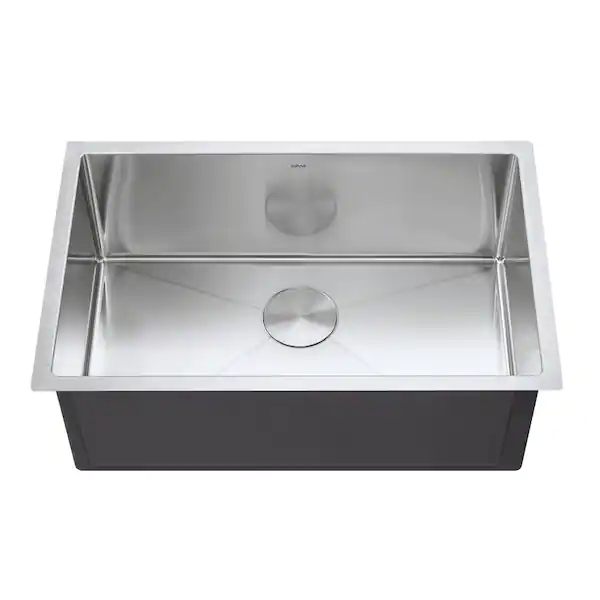
Latest Price On
For number two, we have the Modena under-mount kitchen sink from Zuhne today. It’s a simplistic stainless steel undermount sink that’s great for both personal and professional kitchens.
Sink Size: The sink itself is 28 inches in length with 18-inch width. And the bowl size is respectively 26 and 16 inches. It has a 10-inch deep basin that sits in a minimum cabinet size of 30 inches.
Maintenance: As it’s a stainless steel sink, it’s super easy to maintain and clean. A simple 10-second wipe with a dishwashing liquid will do the trick. It stays sparkling and hygienic without needing to access any special maintenance.
Materials: When it comes to materials, the Modena under-mount kitchen sink only uses the best in the market. IIt’scom posed of indestructible T304 stainless steel. The 16 gauge is uniform in the kitchen basin from top to bottom, thus ensuring 40% more steel than normal sinks.
Functionality: The extra layers of stainless steel definitely make the sink more dent and warp-proof. You can now toss all your hot and heavy pans into the sink without having to worry about any damage.
Furthermore, the thick deck makes this sink the quietest one globally, as it has a 2.5x more noise cancellation and thermal insulation rate.
Accessories: Finally, it also comes with some added accessories like the chef-grade sink set. The single bowl spacious design is great for preventing any clutter and increases the working functionality ten-fold.
Moreover, the sleek look of the sink adds to the overall decor of the kitchen as well as its modern take on traditional sinks.
So, if a traditional-styled undermount sink is what you are after, the Modena Stainless Steel Kitchen Sink is the perfect choice for you.
Pros
- Best steel in the market
-
Simplistic yet useful design
-
Increases overall functionality by a lot
-
2.5 times more insulation than any other brand
-
40% more steel to make it a dense deck
Cons
- Bottom grate can get slimy without proper observation
5. Ruvati rvm4250 single bowl undermount stainless steel kitchen sink
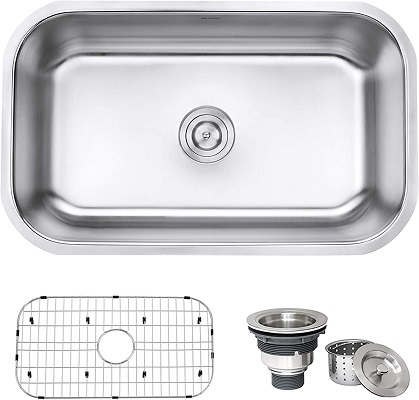
Latest Price On
Here we have the RVM4250 undermount sink from Ruvati. Again, a pretty traditionally set up stainless sink that gets the job done without much hassle.
Variants: Furthermore, the Ruvati RVM420 comes in various size configurations to help you figure out exactly which one you need for your countertop. The lowest size is a 12×18 inches combo, while the largest one is 32×18 inches. For the largest one, the minimum cabinet size is 33”.
Noise Cancellation: This model is a part of the classic Parmi series. It’s an undermount sink, so it fits in easily with any countertop. Furthermore, the dense steel and heavy-duty sound guard padding minimize distractions by lessening all sorts of noise and vibration.
Premium Materials: Speaking of dense steel, the Ruvati RVM420 uses 16-Gauge Premium T-304 Grade Stainless Steel. As a result, it is both rust and stain-resistant. Furthermore, the commercial-grade satin finish gives it a permanent shine and is easy to maintain and clean.
Drainage System: This single bowl undermount sink comes with a standard 3.5” drain opening, which is perfect for any garbage disposal unit. Furthermore, the 9” deep bowl with gently rounder corners optimizes the overall drainage functionality. Maximum water disposal is ensured due to the curved sides and sloped bottoms.
Accessories: Finally, this undermount sink also comes with a bunch of kitchen accessories. For example basket strainer drain assembly, stainless steel bottom rinses grids, mounting brackets, installation guide, etc.
Overall, if a classic and traditional-looking sink with modern amenities is what you are after, this is the one you should go for.
Pros
- Stain-resistant
-
Rust-resistant
-
Sturdy and durable
-
Luxurious satin finish
-
Premium quality stainless steel
Cons
- Sink grid comes with rubber feet
6. Zuhne stainless steel single bowl kitchen sink
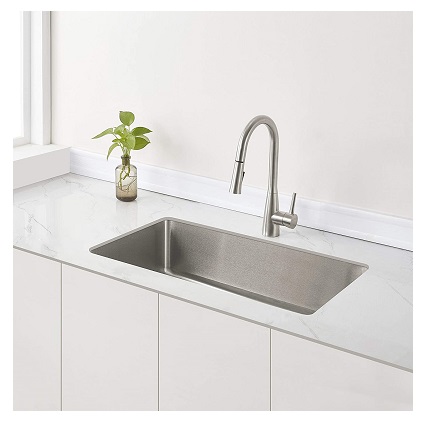
Latest Price On
ZUHNE is a really common and popular name in the kitchen sink world. They are a certified product brand in both US and Canada. So, when we decide to bring up one of their under-mount sinks, you know it’s bound to be reliable.
Size: This single bowl sink from Zuhne is a large 32-inch stainless steel sink. It fits in perfectly with a cabinet size of 34″.
Reversible drains: The Zuhne undermount sink comes with a reversible drainage system. You can reverse easily from right to left drain at will. Also, you can enable the top mount sink with the right drain via the single-hole deck.
Framework: This model is famous for its ultra-scratch and impact-resistant framework. It’s composed of T-304 16-Gauge stainless steel inside out.
Unlike most other undermount sinks, it doesn’t boast a thick deck only has weak structural integrity within. Rather, its deck is uniform both on the outside and the inside.
Insulation: The heavy-duty stainless not only works effortlessly against zero rust damage but also provides great thermal insulation. Now, you can easily put all your hot pots and pans in the sink without having to worry about warping or straining.
Even though it has a bottom grate underneath to prevent scratches, you can use a separate scratch protector to make it more scratch-resistant.
Special features: Finally, the quality craftsmanship ensures a gentle curvy edge to prevent water from staying on the surface or clog. 30-second routine maintenance is enough to keep the sink clean and hygienic. You can also convert the sink to a workstation for your prepping needs if you want to!
So, if a multi-purpose authentic-looking undermount sink is what you need for your kitchen, we cannot recommend ZUHNE enough.
Pros
- Premium quality industrial grade stainless steel
-
Spacious and deep basin
-
Bottom grate to prevent scratches
-
Reversible drainage system
-
2.5 times more insulation
-
Reversible workstation
Cons
- No definite complaints so far
7. Kraus khu101-23 undermount single bowl stainless steel kitchen sink
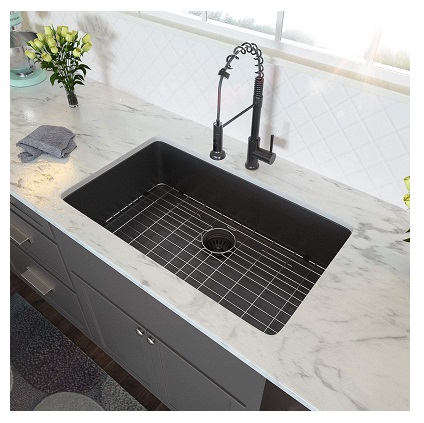
Latest Price On
Here, we have another undermount sink model from Kraus, featuring the KHU101-23. Even though it has a super simplistic design, it offers a much higher functionality rate.
Easy Maintenance: The KHU101-23 is a great option for homeowners who are super new to kitchen activities. The simplistic design is easy to understand, and use, and, more importantly, doesn’t require heavy maintenance. It’s really durable and sturdy and therefore can face whatever you throw at it head-on.
Durability: The super sturdy framework is due to the 1.5 mm thick indestructible stainless steel construction. It doesn’t dent easily, and there is no warping activity going on either. Kraus uses only the best materials for its sinks, and KHU101-23 is made of Tru16 real 16-Gauge T304 stainless steel.
Size: It comes in a variety of sink sizes, starting from a mere 10 inches only. The size can go up to 30 inches to fit 32-Inch cabinet areas. However, the minimum cabinet size stands at 27″.
Depth: This top-rated stainless steel kitchen sink is super deep and thus, super spacious. It’s a perfect combo for both a compact and commercial kitchen due to all the extra space it provides. You can just as easily use it for a meal prep or entertainment area as well.
Noise Cancellation: The entire sink, in addition to having dense steel, is covered by thick rubber dampening pads and non-toxic stone guard undercoating. It covers over 80% of the sink that supports the high-performance noise-defend soundproofing technology.
Overall, if you are a beginner looking to test out the waters, this sink is the perfect choice for you to start with.
Pros
- Commercial-grade satin finish
-
Sound-deadening technology
-
Tru16 thick deck stainless steel
-
Non-toxic undercoating
-
Multiple free accessories
Cons
- Can scratch easily if you are being too inconsiderate
8. Lordear undermount single bowl stainless steel kitchen sink
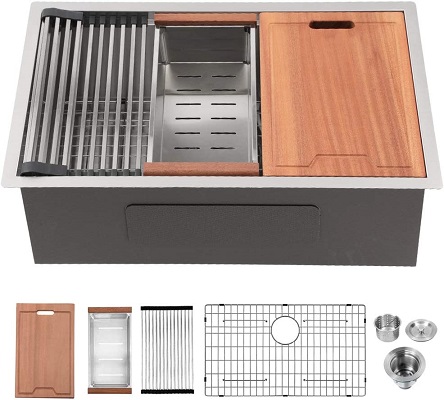
Latest Price On
Let’s introduce another one of our top contenders in the market— the Lordeal Kitchen Sink from well, Lordear. Highly efficient with a great and durable design – there’s nothing about that combo that we don’t love.
Size & Installation: The Lordear sink is a single bowl undermount sink that has a Farmhouse-Apron-Front installation method. It comes in variable sizes and configurations. The lowest size available in the Lordeal kitchen sink series is 13-inch while the largest one is up to 30 inches with a 19-inch width.
Stylish Design: When we say that the Lordeal under-mount sink has a great design, we are referring to the gunmetal black framework of this sink. The luxurious matte black finish gives off a super regal look which goes perfectly with this dark color.
As for material, this model uses T304 16-Gauge thick panel stainless steel.
Functionality: The thick panel stainless steel can withstand a high temperature of up to 1000 degrees Celsius without fading or warping. It’s also obviously rusted and water-resistant due to the copper and iron combo in stainless steel. The surface has a nano-brushed covering that gives off similar effects to non-stick surfaces.
Drainage System: On the other hand, the 10-inch deep basin is perfect for not only storing multiple pots and pans but also for curved sides and sloped bottoms. The X-shaped diversion design resists water blockage and ensures fast and non-seepage drainage. It features an anti-freezing mechanism as well to maximize functionality.
Accessories: Finally, like most other top-rated sinks, the Lordeal undermount sink also comes with a bunch of kitchen accessories. For example, the package includes a 304 stainless steel dish grid, drain assembly, cotton apron, oven mitts, oven gloves, etc.
So, Lordear can definitely offer the most bang for your buck when it comes to undermount kitchen sinks. It’s a pretty great option for both beginners and professionals.
Pros
- Thick-plated stainless steel
-
Easy installation method
- Can withstand high temperature
-
Non-stick like surface
-
Anti-freezing mechanism
Cons
- Prone to water spots when exposed to hard water
9. Ruvati single bowl undermount stainless steel kitchen sink
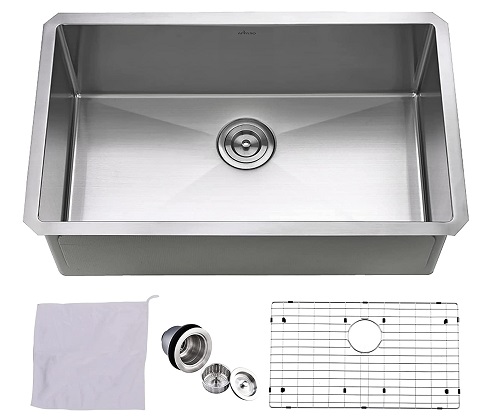
Latest Price On
Ruvati makes yet another appearance on our list of the best undermount stainless steel kitchen sinks. This time, we will be talking about the RVH7300 undermount sink model from Ruvati.
Configurations: Starting from a mere 10-inch only, the RVH7300 is available in different size variants up to 33-inch sinks. The depth of the sink basin is, however, constant and stands at 10 inches. This stainless steel undermount sink is a part of the Gravena series from Ruvati.
Durability: Ruvati is known for its sturdy and long-lasting kitchen products and the RVH7300 is no different. The framework is made of premium-grade T-304 16-Gauge stainless steel. Not only it’s highly durable, but it’s also 37% thicker than most other kitchen sinks on the market.
Great Finish: Stainless steel sinks are already super easy to maintain and clean. On top of that, the RVH7300 has a commercial-grade brush finish that takes just a few swipes to clean off fully.
There’s no water damage or clogging as well due to the sloped bottom with multiple grooves.
Noise Cancellation: Furthermore, the tight radius corners that are heavily padded with soundproof materials, help to reduce the annoying cluttering noises. The undercoating provides great insulation for both heat and sound. Plus, the added accessories like bottom grids and basket strainer drain reduce the possibility of scratches and scrubbing stains.
Overall, if you are looking for something trustworthy, minimalistic, and long-lasting, the Ruvati RVH7300 is a pretty great option.
Pros
- T-304 grade stainless steel
-
Commercial brushed finish
-
Comes with two basket strainer drains
-
Well and sturdy build-up
-
Heavy-duty sound-guard padding
Cons
- Might need regular upkeep and maintenance
10. APPASO 16-gauge stainless steel single bowl kitchen sink

Latest Price On
Further down the list, we have the HS3219 Kitchen Sink model from APPASO. The design of this model is quite similar to that of the previous model in this list, but still a great sink nonetheless.
High Sturdiness: APPASO boasts in their HS3219 model regarding the overall longevity even with long-time heavy-duty use. The sink itself is made from industrial grade 18/10 T304 Tru16 1.5 mm thick stainless steel.
Not only APPASO features 25% more steel in their undermount sinks, but their steel plates are also 37% thicker than the rest of the sinks in the market.
Durability: By now, it’s pretty obvious that these thick plates of steel aren’t susceptible to deformity or warping even in extreme conditions.
Again, extra-thick rubber padding covers about 95% of the surface that provides great insulation against both heat and sound. It’s also protected against possible collision friction and deep scratches.
Recyclable Sink: Another great reason to choose APPASO is their 100% recycling policy for all products. The materials used in HS3219 are prepared based on ISO standard production process.
As a result, they are non-toxic, lead-free, and fully recyclable, which is amazing for both human health and the environment.
Working Space: Finally, as it’s a deep single-bowl stainless steel sink of 10 inches, it has a massive working space. The tightly rounded corners are great for overall waste and water disposal. And the 95-degree straight sides around the sink reduce splashing and can accommodate more pots and pans at any given time.
Therefore, if you are looking for an environment-friendly single bowl undermount sink, The APPASO kitchen sink is the right option for you.
Pros
- Lead-free
-
95-degree straight edges
-
Industrial grade materials
-
Non-toxic undercoating
-
100% recyclable
Cons
- No such definite cons for this sink
11. Torva undermount stainless steel single bowl kitchen sink
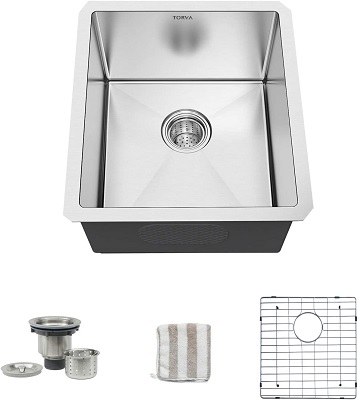
Latest Price On
Our penultimate product in this review is the TORVA Undermount Stainless Steel Kitchen Sink that features a single bowl with reversible prep corners.
Geometric Design: The TORVA kitchen sink has a weirdly concise undermount position that fits in so perfectly with the countertop that it’s almost seamless. They played off a geometric style by incorporating these zero-radius corners for a sleek and modern design.
Materials: When it comes to construction, TORVA is on our list for top-rated stainless steel undermount sinks for a reason. Like most other kitchen sinks on the list so far, they also use premium-grade T304 stainless steel as their sink framework.
As a result, it’s sturdy, durable, and protected against corrosion as well.
Size Variants: This model is available in at least six different sizes to give everyone a proper option according to their countertop. The size ranges from 14 to 32 inches. You can also upgrade the 14×18-inch variant to other sizes if you want to.
Functionality: The 8.5” deep bowl with the sink might not have much depth as some of the other sinks in this list. However, it easily covers up that shortcoming by allowing a greater width and seamless transition from counter-top to sink.
It also comes with a durable bottom grate to save your surface from extra friction and scratch.
Drainage System: Other than that, it features a standard 3.5” drain opening for a proper garbage disposal unit. In addition to sound-dampening pads, the TORVA undermount sink has an anti-condensation protective layer. This layer keeps the surface clean and glistening by preventing moisture accumulation.
All in all, The TORVA undermount kitchen sink is a great choice for those people who are looking for a futuristic design with high functionality.
Pros
- Sleek and modern design
-
Anti-condensation protective layer
-
Almost non-existent transition
-
Zero-radius corners
-
Upgradable features
Cons
- Drain is deeper than usual sinks
12. Sarlai single bowl undermount kitchen sink
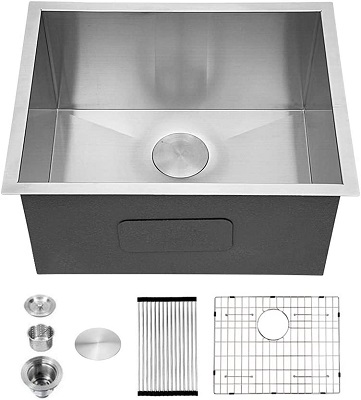
Latest Price On
Last but not the least, we have the much-loved utility sink from Sarlai. This is the deepest sink on our list so far, and we love how it works and performs!
Multi-Purpose Sink: The Sarlai Single Bowl Utility Sink is made for both kitchen and laundry room purposes. Since it has an undermount installation method, it can seamlessly integrate with any countertop.
Thus, be it clothes or veggies that need washing, The Sarlai sink has your back in both cases.
Materials: As we have mentioned before, all our products on the list for today incorporate only the best materials in their models. Sarlai is no different as well since they, too, use 16-gauge Tru16 T304 stainless steel for the structural framework of their sinks.
As a result, not only is it rust and water-resistant, but also a durable and long-lasting sink.
Depth: Now, let’s talk about the main attraction of this sink. The mega 12” depth can accommodate so many utensils at once. As it has a much larger depth, it is used as a laundry or utility sink as well sometimes.
Special Features: The minimum cabinet size that can adhere to this kitchen sink is 27 inches. Complete water drainage is achieved due to the X-shaped diversion design on the bottom surface.
Furthermore, sound-guard undercoating and heavy rubber padding work to achieve maximum quietness during cleaning or washing. All in all, anyone looking to get a multi-purpose and deep sink should definitely invest in the Sarlai Single Bowl Undermount Kitchen Sink.
Pros
- Heavy-duty sound guard padding
-
Deeper basin than usual
-
Seamless appearance
-
Easy-to-use design
-
Diversion design for maximum disposal
Cons
- Surface is a bit too flat for thicker liquids
Buying guide: What to look for when buying stainless steel undermount sink?
What to look for before buying can haunt you, right?
Doing research with due diligence can help you find long-lasting, and better specifications undermount kitchen sinks. However, if you get caught up in a cost trap and waste your time without choosing wisely, that could be of no use to you.
We’ve come to this point to clarify your general understanding of how or what things you should check before purchasing an undermount kitchen sink
Gauge
The gauge determines the thickness of the metal. The higher the gauge, the thinner the metal and the more susceptible it is to dents and cracks, like 22-gauge thickness stainless steel.
A stainless steel kitchen sink’s standard gauge is 16 gauge for a high-end sink and 18 gauge for a more reasonably priced sink. It is better to choose the lowest number of gauges so you can get a durable and silent one.
Sink finish and material
The kitchen sink is made from stainless steel, granite composite, ceramic, quartz, and a variety of other materials. Stainless steel fills nearly all of our checklists, whereas granite falls into the pricey category, ceramic tends to crack, and quartz sinks have a limited range of customization options.
If you want to exude a super regal vibe, a marble kitchen sink is by far your best option and will exquisitely adorn your surroundings. Stainless steel and quartz, however, are superior for heavy use.
The preferred stainless steel sink finishes include electroplate, brushed and matte finishes, satin, decor, and polish. The heat and stain resistance of stainless steel, however, makes it the clear winner when it comes to sink finishes.
Sink size and depth
Most people tend to worry about this one: “Which kitchen sink size is ideal for you?” Kitchen length, depth, and cabinet dimensions are determining the sink size. But moreover, the sink size is your own choice.
For example, farmhouse kitchen sinks are the ideal option if you have a large family or enjoy cooking because they are typically wider and deeper than regular sinks. Additionally, an undermount kitchen sink has a smaller radius corner that will fit any kitchen size, regardless of how big or small it is.
Shape and configuration
The countertop’s cutout determines the shape of the kitchen sinks. Kitchen sinks come in a variety of shapes, including rectangular, square, rounded, oval-shaped, D-shaped, L-shaped, and corner sinks. Whatever shape you choose, make sure it matches the kitchen interior.
When it comes to choosing the configuration before purchasing a kitchen sink, single-bowl, double-bowl, triple-bowl, workstations, and smart or low-divide are all options to consider.
Single-bowl kitchen sinks are mostly required for mobile homes, small kitchens, double-bowl sinks, and workstations for restaurant chefs, cooking lovers, and large kitchens, and even sometimes for mobile homes.
Noise and heat insulation
It’s important to keep in mind that the kitchen can be quite noisy and warm before you purchase a sink for it. The sound of utensils rattling all the time can be very annoying, especially in the sink. For situations like these, you should search for a kitchen sink that supports noise suppression technologies.
Check out the quality of the rubber paddings as well. Make sure to go for the ones that are non-toxic and lead-free.
And when it comes to heat insulation, it’s best to go for stainless steel sinks, as they have a much higher heat capacity than most. Granite or ceramic sinks can easily crack if exposed to high heat for a long time.
Meanwhile, stainless steel won’t even flinch much no matter how long you keep your hot pots and pans on the surface.
Brand and price
Ruvati, Kraus, Kohler, Elkay, MR Direct, Zuhne, American Standard, and Moen are, surprisingly, the most famous manufacturers in this industry. The best products in each price range are available from them.
The build quality, style, and size options are suitable for almost any budget. However, we must admit that in the line of undermount sinks, the 304-grade stainless steel sinks are the most well-liked.
Frequently asked questions of undermount stainless steel sink
Why should you choose stainless steel sinks?
They’re easy to maintain, clean, and last longer. Without having to worry about the surface getting damaged, even you can easily keep your hot pan or pot.
Is an under-mount sink better?
Undermount sink is mostly preferred sink by homeowners, restaurant chefs, or other commercial kitchens due to their ease of cleaning and saving enough space.
Is an under-mount sink better than a top-mount sink?
It’s hard to pick one because both undermount and top-mount sinks are better on their own terms. Undermount sinks are installed underneath the counter which releases more counter space to work with, whereas top-mount sinks are great at the installation process.
What size under-mount sink do I need?
The length and width of the countertop cutout determine the size of the undermount sink you need. However, the standard for single bowls is up to 36 inches wide, while for double bowls it is up to 48 inches wide.
Is it a wise decision to buy a stainless steel sink?
Undoubtedly, it is! It gives you more value than other undermount sink materials.
Is a stainless steel sink better than granite?
Although stainless steel sinks are a cheaper option than granite sinks, they are less scratch-resistant, while both are durable and made with high-quality materials.
What is the best stainless steel for the kitchen sink?
304 grade and 16 or 18-gauge stainless steel are the best for kitchen sinks and other kitchen appliances.
What is a good grade of stainless steel for a kitchen sink?
The stainless steel grades 304 and 316 are suitable for kitchen sinks. The 16 gauge undermount kitchen sink is significantly more expensive, so most housewives or chefs in restaurants opt for the 18 gauge 304-grade stainless steel option.
Which sink is better quartz or stainless steel?
Both are the best options when it comes to durability, but stainless steel may be the best overall option. Quartz may also be the better choice due to its design availability and scratch resistance. Now everything hinges on your preferences.
How long should an undermount sink last?
It depends on the materials you pick and how well you take care of your undermount kitchen sink. If there is no sagging or improper installation, the undermount sink typically lasts between 5 and 10 years.
Which is better an 18 or 20-gauge stainless steel sink?
Undoubtedly an 18 gauge! The smaller the gauge number, the thicker the stainless steel. While 20 gauge is significantly thinner, it is more likely to get dented or damaged soon.
Do all stainless steel sinks scratch easily?
Yes, it is! Stainless steel scratches appear easily due to limescale buildup from water. However, you can remove the minor ones by rubbing them with soft towels or cloth after applying olive oil.
Does a plumber install an undermount sink?
Definitely, yes! Without a plumber’s help, you might fix an undermount sink incorrectly because they are typically difficult to install and are heavy to move.
Final Words
Time to wrap up our blogs on kitchen improvement.
Since the kitchen is where memories are created, every homeowner must pay attention to its interior. If the kitchen counter has a vintage, sleek look with a modern touch, that would be the cherry on top. That only happens when you choose the ideal undermount kitchen sink.
Hope, our blog answers all of your questions and is able to provide a thorough overview of stainless steel kitchen sinks.
Don’t forget to leave your comments below. See you on the next blog!

